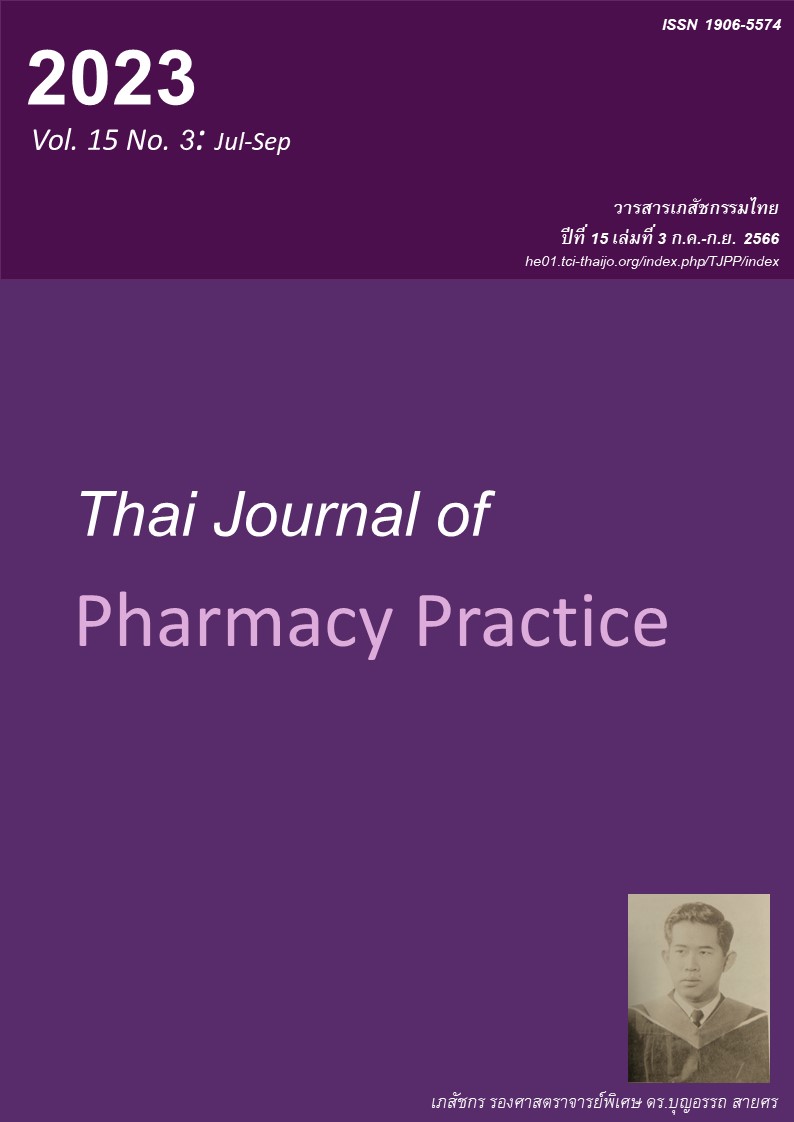ผลลัพธ์ของการแทรกแซงหลากหลายรูปแบบเพื่อลดการสั่งยาปฏิชีวนะที่ไม่จำเป็นในผู้ป่วยนอก โรคติดเชื้อทางเดินหายใจส่วนบนเฉียบพลัน ณ โรงพยาบาลสมเด็จพระบรมราชเทวี ณ ศรีราชา
Main Article Content
บทคัดย่อ
วัตถุประสงค์: เพื่อวิเคราะห์ผลลัพธ์ของการแทรกแซงหลากหลายรูปแบบเพื่อลดการสั่งยาปฏิชีวนะที่ไม่จำเป็นในผู้ป่วยนอกโรคติดเชื้อทางเดินหายใจส่วนบนเฉียบพลัน (acute upper respiratory infections: AURI) ณ โรงพยาบาลสมเด็จพระบรมราชเทวี ณ ศรีราชา วิธีการ: การแทรกแซงหลากหลายรูปแบบในการศึกษานี้ คือ 1) การส่งข้อมูลย้อนกลับของการสั่งยาปฏิชีวนะใน AURI ของแพทย์แบบภาพรวมและรายบุคคล 2) การเผยแพร่แนวทางการรักษา AURI ทางอินทราเน็ตของโรงพยาบาล และ 3) การจัดทำคำแนะนำการสั่งยาปฏิชีวนะอย่างสมเหตุผลที่จำแนกตาม ICD-10 และกำหนดเป็นนโยบายในการสั่งใช้ยาของโรงพยาบาล ผู้วิจัยเก็บข้อมูลการสั่งยาปฏิชีวนะและค่าใช้จ่ายของยาปฏิชีวนะใน AURI เป็นเวลา 12 เดือนก่อนและหลังการแทรกแซงในโรงพยาบาล ผลการวิจัย: ในภาพรวม แพทย์สั่งยาปฏิชีวนะในผู้ป่วยนอกโรค AURI ลดลงร้อยละ 19.5 (จากร้อยละ 29.2 เป็น 9.7; P<0.001) เมื่อจัดประเภทการสั่งยาปฏิชีวนะตาม ICD-10 ของผู้ป่วย พบว่า กลุ่มโรคที่การสั่งยาปฏิชีวนะถือว่าเป็นการใช้ยาที่สมเหตุผลมีอัตราการสั่งยาปฏิชีวนะลดลงร้อยละ 39.1 (จากร้อยละ 80.4 เป็น 41.3; P<0.001) กลุ่มโรคที่ไม่ควรสั่งยาปฏิชีวนะ อัตราการสั่งยาปฏิชีวนะลดลงร้อยละ 13.0 (จากร้อยละ 19.3 เป็น 6.3; P<0.001) คลินิกโรคติดเชื้อทางเดินหายใจเฉียบพลันเป็นคลินิกที่มีผู้ป่วยเข้ารับบริการมากที่สุด และมีอัตราการสั่งยาปฏิชีวนะลดลงร้อยละ 20.6 (จากร้อยละ 25.5 เป็น 4.9; P<0.001) ค่าใช้จ่ายของยาปฏิชีวนะก่อนและหลังแทรกแซงลดลง 80,905 บาทในหนึ่งปี (หรือ 11.1 บาท/การรักษา AURI หนึ่งครั้ง) สรุป: การแทรกแซงหลากหลายรูปแบบในการวิจัยครั้งนี้สามารถลดการสั่งยาปฏิชีวนะที่ไม่จำเป็นในโรค AURI รวมทั้งลดค่าใช้จ่ายของยาปฏิชีวนะในโรงพยาบาล
Article Details

อนุญาตภายใต้เงื่อนไข Creative Commons Attribution-NonCommercial-NoDerivatives 4.0 International License.
ผลการวิจัยและความคิดเห็นที่ปรากฏในบทความถือเป็นความคิดเห็นและอยู่ในความรับผิดชอบของผู้นิพนธ์ มิใช่ความเห็นหรือความรับผิดชอบของกองบรรณาธิการ หรือคณะเภสัชศาสตร์ มหาวิทยาลัยสงขลานครินทร์ ทั้งนี้ไม่รวมความผิดพลาดอันเกิดจากการพิมพ์ บทความที่ได้รับการเผยแพร่โดยวารสารเภสัชกรรมไทยถือเป็นสิทธิ์ของวารสารฯ
เอกสารอ้างอิง
World Health Organization. WHO strategic priorities on antimicrobial resistance [online]. 2022. [cited June 7, 2022]. Available from: www.who.int/publicat ions/i/item/9789240041387
Shallcross LJ, Davies DS. Antibiotic overuse: a key driver of antimicrobial resistance. Br J Gen Pract 2014; 64: 604-5.
Fleming-Dutra KE, Hersh AL, Shapiro DJ, Bartoces M, Enns EA, File TM Jr, et al. Prevalence of inappro priate antibiotic prescriptions among US ambulatory care visits, 2010-2011. JAMA 2016; 315: 1864-73.
Schroeck JL, Ruh CA, Sellick JA Jr, Ott MC, Mattappallil A, Mergenhagen KA. Factors associated with antibiotic misuse in outpatient treatment for upper respiratory tract infections. Antimicrob Agents Chemother 2015; 59: 3848-52.
Walsh TL, Taffe K, Sacca N, Bremmer DN, Sealey ML, Cuevas E, et al. Risk factors for unnecessary antibiotic prescribing for acute respiratory tract infections in primary care. Mayo Clin Proc Innov Qual Outcomes 2020; 4: 31-9.
Degnan KO, Cluzet V, David MZ, Dutcher L, Cressman L, Lautenbach E, et al. Development and validation of antibiotic stewardship metrics for out- patient respiratory tract diagnoses and association of provider characteristics with inappropriate prescribing. Infect Control Hosp Epidemiol 2022; 43: 56-63.
Waleekhachonloet O, Rattanachotphanit T, Limwatta nanon C, Thammatacharee N, Limwattananon S. Effects of a national policy advocating rational drug use on decreases in outpatient antibiotic prescribing rates in Thailand. Pharm Pract (Granada) 2021; 19: 2201. doi: 10.18549/PharmPract.2021.1.2201.
Junkunapas P, Boonyarit P, Srisuphan V, Yuangruan grong P, Prapaso N. Service plan: rational drug use. Nonthaburi: Office of Permanent Secretary Ministry of Public Health; 2016.
Rubin MA, Bateman K, Alder S, Donnelly S, Stoddard GJ, Samore MH. A multifaceted intervention to improve antimicrobial prescribing for upper respira- tory tract infections in a small rural community. Clin Infect Dis 2005; 40: 546-53.
Yadav K, Meeker D, Mistry RD, Doctor JN, Fleming-Dutra KE, Fleischman RJ, et al. A multifaceted intervention improves prescribing for acute respira- tory infection for adults and children in emergency department and urgent care settings. Acad Emerg Med 2019; 26: 719-31.
Figueiras A, López-Vázquez P, Gonzalez-Gonzalez C, Vázquez-Lago JM, Piñeiro-Lamas M, López-Durán A, et al. Impact of a multifaceted intervention to improve antibiotic prescribing: a pragmatic cluster-randomised controlled trial. Antimicrob Resist Infect Control 2020; 9: 195. doi:10.1186/s13756-020-0085 7-9.
Livorsi DJ, Nair R, Dysangco A, Aylward A, Alexan- der B, Smith MW, et al. Using audit and feedback to improve antimicrobial prescribing in emergency departments: A multicenter quasi-experimental study in the veterans health administration. Open Forum Infect Dis 2021; 8: ofab186. doi:10.1093/ofid/ofab 186.
van der Velden AW, Pijpers EJ, Kuyvenhoven MM, Tonkin-Crine SK, Little P, Verheij TJ. Effectiveness of physician-targeted interventions to improve antibio tic use for respiratory tract infections. Br J Gen Pract 2012; 62: e801-7.
Squires JE, Sullivan K, Eccles MP, Worswick J, Grimshaw JM. Are multifaceted interventions more effective than single-component interventions in changing health-care professionals' behaviours? An overview of systematic reviews. Implement Sci 2014; 9: 152. doi: 10.1186/s13012-014-0152-6.
Tongsiri S, Saensak S, Ploylearmsang C, Promsatta yaprot V, Klangkan S. Systematic literature review project report of public health policy research to achieve effective implementation [online]. 2017. [cited June 10, 2022]. Available from: 164.115.27.97 /digital/files/original/67bafe762 4e72b53088869f0f962d85f.pdf
Sumpradit N, Chongtrakul P, Anuwong K, Pumtong S, Kongsomboon K, Butdeemee P, et al. Antibiotics smart use: a workable model for promoting the rational use of medicines in Thailand. Bull World Health Organ 2012; 90: 905-13.
Pumtong S, Duangchan P, Anuwong K, Sumpradit N. Lessons learnt from scaling up to sustainability of antibiotics smart use (ASU). Journal of Health Science 2017; 11: 500-15.
Boonyasiri A, Thamlikitkul V. Effectiveness of multifa ceted interventions on rational use of antibiotics for patients with upper respiratory tract infections and acute diarrhea. J Med Assoc Thai 2014; 973:S13-9.
Aoybamroong N, Kantamalee W, Thadanipon K, Techasaensiri C, Malathum K, Apiwattanakul N. Impact of an antibiotic stewardship program on antibiotic prescription for acute respiratory tract infec tions in children: A prospective before-after study. Clin Pediatr (Phila) 2019; 58: 1166-74.
Pothidorkmai Y. A model to monitor rational use of antibiotics in Chiang Yuen hospital, Mahasarakham province. Journal of Health Science 2017; 26: S97-105.
Siriboriruk J, Suwannalert C, Dinchuthai P, Chun chom gul C. An effective strategy to reduce the overprescription of antibiotics by clinicians in the hospital’s outpatient and emergency departments. Burapha Journal of Medicine 2021; 8: 26-41.
Leung V, Langford BJ, Ha R, Schwartz KL. Metrics for evaluating antibiotic use and prescribing in outpatient settings. JAC Antimicrob Resist 2021; 3: dlab098. doi: 10.1093/jacamr/dlab098.


